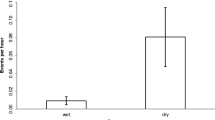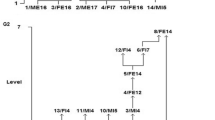Abstract
Several aspects of the social system of spider monkeys remain poorly understood in spite of previous studies of their behavior. Our work investigates sex differences of adultAteles geoffroyi to develop a better understanding of their social organization. A six-month field study of this species in Guatemala showed that adult males were both more aggressive and more socially cohesive than females, as well as more territorial. Adult females were more vocal, more submissive, more nonsocial, and more dispersed than adult males. Males were more likely to associate affinitively with other males than with females, and to direct their aggressive behaviors at females rather than males. Spider monkey society was found to be sex-segregated; males traveling and interacting in all-male subgroups, while females travel alone or with offspring.
These findings are used, in conjunction with other evidence, to draw inferences about the dynamics of theAteles social system, and to derive an explanation for the evolution of spider monkey social organization. The frugivorous diet ofAteles is linked to the dispersion females and to the cohesion of related adult males, who form cooperative territorial groups, in which the low level of male-male competition is related to the absence of sexual dimorphism. Spider monkeys provide an illuminating contrast to the general primate model, derived from Old World monkeys, which links sexual dimorphism in size to sex differences in behavior, and ultimately to sexual selection.
Similar content being viewed by others
References
Baxter, M. J., 1979. Behavioral patterns relating to age and sex in free-ranging spider monkeys (Ateles geoffroyi) in Tikal National Park, Guatemala. Master's thesis, Univ. of Alberta, Edmonton.
Bernstein, I. S., 1970. Primate status hierarchies. In:Primate Behavior, Vol. 1,L. A. Rosenblum (ed.), Academic Press, New York, pp. 71–109.
————, 1971. Activity profiles of primate groups. In:Behavior of Nonhuman Primates, Vol. 3,A. M. Schrier &F. Stollnitz (eds.), Academic Press, New York, pp. 69–106.
————, &T. P. Gordon, 1974. The function of aggression in primate societies.J. Theor. Biol., 60: 459–472.
Bramblett, C. A., 1970. Coalitions among gelada baboons.Primates, 11: 327–333.
————, 1976.Patterns of Primate Behavior. Mayfield Press, Palo Alto.
Bygott, J. D., 1979. Agonistic behavior, dominance, and social structure in wild chimpanzees of Gombe National Park. In:The Great Apes. Perspectives on Human Evolution, Vol. 5,D. Hamburg &E. R. McCown (eds.), Benjamin/Cummings Publ. Co., Menlo Park, pp. 405–427.
Cant, J., 1976. Ecology, locomotion, and social organization of spider monkeys (Ateles geoffroyi). Ph. D. dissertation, Univ. of California, Davis.
————, 1978. Population survey of the spider monkeyAteles geoffroyi at Tikal, Guatemala.Primates, 19: 525–535.
Carpenter, C. R., 1935. Behavior of red spider monkeys in Panama.J. Mammal., 16: 171–180.
Coelho, A. M. Jr., C. A. Bramblett, L. B. Quick &S. Bramblett, 1976. Resource availability and population density in primates: a sociobioenergetic analysis of energy budgets of Guatemalan howler and spider monkeys.Primates, 17: 63–80.
————,L. Coelho, C. A. Bramblett, S. Bramblett &L. Quick, 1977. Ecology, population characteristics, and sympatric association in primates: A sociobioenergetic analysis of howler and spider monkeys in Tikal, Guatemala.Yb. Phys. Anthropol., 20: 96–135.
Crook, J. H., 1972. Sexual selection, dimorphism and social organization in the primates. In:Sexual Selection and the Descent of Man 1871–1971.B. Campbell (ed.), Aldine, Chicago, pp. 231–281.
Demment, M. W., 1978. Nutritional constraints on the evolution of body size in baboons. Paper prepared for participants in “Baboon Field Research: Myths and Models” (unpubl. ms.).
Downhower, J. F., 1976. Darwin's finches and the evolution of sexual dimorphism in body size.Nature, 263: 558–563.
Eisenberg, J. F., 1976. Communication mechanisms and social integration in the black spider monkey,Ateles fusciceps and related species.Smithsonian Contr. Zoo., 113.
————, &R. E. Kuehn, 1966. The behaviour ofAteles geoffroyi and related species.Smithsonian Misc. Coll., 151: 1–63.
Fedigan, L. M., 1982.Primate Paradigms. Sex Roles and Social Bonds. Eden Press, Montreal.
Hamilton, M., 1975. Variation in the sexual dimorphism of skeletal size in five populations of Amer.-indians. Ph.D. dissertation, Univ. of Michigan, Ann Arbor.
Hrdy, S. B., 1979.The Langurs of Abu. Male and Female Strategies of Reproduction. Harvard Univ. Press, Cambridge.
Izawa, K., K. Kimura &A. S. Nieto, 1979. Grouping of the wild spider monkey.Primates, 20: 503–512.
Jarman, P., 1974. The social organization of antelope in relation to their ecology.Behaviour, 48: 215–267.
Kaplan, J. R., 1977. Patterns of fight interference in free-ranging rhesus monkeys.Amer. J. Phys. Anthropol., 47: 278–288.
Klein, L. L., 1971. Observations on copulation and seasonal reproduction of two species of spider monkeys,Ateles belzebuth andAteles geoffroyi.Folia Primatol., 15: 233–248.
————, 1972. The ecology and social organization of the spider monkey,Ateles belzebuth. Ph.D. dissertation, Univ. of California, Berkeley.
————, 1974. Agonistic behaviour in neotropical primates. In:Primate Aggression, Territoriality, and Xenophobia,L. Holloway (ed.), Academic Press, New York, pp. 77–122.
————, &D. J. Klein, 1971. Aspects of social behavior in a colony of spider monkeysAteles geoffroyi.Int. Zoo. Yb., 11: 175–181.
———— & ————, 1973, Observations on two types of neotropical primate intertaxa associations.Amer. J. Phys. Anthropol., 38: 649–654.
————, & ————, 1975. Social and ecological contrasts between four taxa of neotropical primates. In:Socioecology and Psychology of Primates,R. Tuttle (ed.), Mouton, The Hague pp. 59–85.
————, & ————, 1976. Neotropical primates: Aspects of habitat use, space, population density and regional distribution in La Macarena, Colombia. In:Neotropical Primates. Field Studies and Conservation,R. W. Thorington &P. G. Heltne (eds.), National Academy of Science, Washington, D.C., pp. 70–78.
Lancaster, J. B., 1972. Play-mothering: the relations between juvenile females and young infants among free-ranging vervet monkeys. In:Primate Socialization,F. E. Poirier (ed.), Random House, New York, pp. 83–104.
Leutenegger, W., 1978. Scaling of sexual dimorphism in body size and breeding system in primates.Nature, 272: 610–611.
————, 1979. Evolution of litter size in primates.Amer. Naturalist, 1143: 525–531.
————, 1982. Scaling of sexual dimorphism in body weight and canine size in primates.Folia Primatol., 37: 163–176.
Lundell, C., 1937.The Vegetation of the Peten. Carnegie Inst. of Washington, Washington, D.C.
Marsh, C. W., 1979. Female transfer and mate choice among Tana River red colobus.Nature, 281: 568–569.
McKenna, J. J., 1978. Biosocial functions of grooming behaviour among the common Indian langur monkey (Presbytis entellus).Amer. J. Phys. Anthropol., 48: 503–510.
Mitchell, G. D., 1979.Behavioral Sex Differences in Nonhuman Primates. Van Nostrand Reinhold, New York.
———— &D. H. Tokunga, 1976. Sex differences in nonhuman primate grooming.Behav. Processes, 1: 335–345.
Nagy, K. A. &K. Milton, 1979. Energy metabolism and food consumption by wild howler monkeys (Alouatta palliata).Ecolgoy, 60: 475–480.
Napier, J. R. &P. H. Napier, 1967.A Handbook of Living Primates. Academic Press, New York.
Owen-Smith, R. N., 1975. The social ethology of the white rhinocerosCeratotherium simum (Burchell, 1817).Z. Tierpsychol., 38: 337–384.
Post, D., 1980. Sexual dimorphism in the anthropoid primates: some thoughts on causes, correlates, and the relationship to body size. (unpubl. ms.)
Pusey, A., 1979. Intercommunity transfer of chimpanzees in Gombe National Park. In:The Great Apes. Perspectives on Human Evolution, Vol. 5,D. Hamburg &E. R. McCown (eds.), Benjamin/Cummings Publ. Co., Menlo Park, pp. 465–478.
Raleigh, M. J., J. W. Flannery &F. R. Ervin, 1979. Sex differences in behavior among juvenile vervet monkeys (Cercopithecus aethiops).Behav. Neur. Biol., 26: 445–465.
Ralls, K., 1976. Mammals in which females are larger than males.Quart. Rev. Biol., 51: 245–276.
————, 1977. Sexual dimorphism in mammals: Avian models and unanswered questions.Amer. Naturalist, 111: 917–938.
Richard, A., 1970. A comparative study of the activity patterns and behavior ofAlouatta villosa andAteles geoffroyi.Folia Primatol., 12: 241–263.
Rondinelli, R. &L. L. Klein, 1976. An analysis of adult social spacing tendencies and related social mechanisms in a colony of spider monkeys (Ateles geoffroyi) at the San Francisco Zoo.Folia Primatol., 25: 122–142.
Sade, D. S., 1965. Some aspects of parent-offspring and sibling relations in a group of rhesus monkeys, with a discussion of grooming.Amer. J. Phys. Anthropol., 23: 1–18.
Schultz, A., 1960. Age changes and variability in the skulls and teeth of Central American monkeys,Alouatta, Cebus, andAteles.Proc. Zool. Soc., Lond., 133: 337–390.
Trivers, R. L., 1972. Parental investment and sexual selection. In:Selection and the Descent of Man 1871–1971,B. Campbell (ed.), Aldine, Chicago, pp. 136–179.
van den Berghe, P. L., 1973.Age and Sex in Human Societies: A Biosocial Perspective. Wadsworth Publ. Co., Belmont.
Wolfheim, J. H., 1977. Sex differences in behaviour in a group of captive juvenile talapoin monkeys (Miopithecus talapoin).Behaviour, 63: 110–128.
Wrangham, R. W., 1979a. On the evolution of ape social systems.Soc. Sci. Inform., 18: 335–368.
————, 1979b. Sex differences in chimpanzee dispersion. In:The Great Apes. Perspectives on Human Evolution, Vol. 5,D. Hamburg &E. R. McCown (eds.), Benjamin/Cummings Publ. Co., Menlo Park, pp. 481–489.
————, 1980. An ecological model of female-bonded primate groups.Behaviour, 75: 262–300.
Author information
Authors and Affiliations
About this article
Cite this article
Fedigan, L.M., Baxter, M.J. Sex differences and social organization in free-ranging spider monkeys (Ateles geoffroyi). Primates 25, 279–294 (1984). https://doi.org/10.1007/BF02382267
Received:
Accepted:
Issue Date:
DOI: https://doi.org/10.1007/BF02382267




